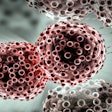
Writing in Nucleic Acids Research, scientists at Hokkaido University in Japan and the KTH Royal Institute of Technology in Sweden recently described the development of a technique for studying a RNA structure called a G-quadruplex.
Nucleic acids that are rich in guanine are prone to assembling into the four-stranded structure and are associated with the disease amyotrophic lateral sclerosis (ALS).
Akira Kitamura, from the Faculty of Advanced Life Science at Hokkaido, explained the normal role of the structures and how they may contribute to neurodegenerative diseases such as ALS in a statement.
"Normally, these structures regulate the expression of genes. However, a mutation in chromosome 9 in humans results in the formation of G-quadruplexes that may play a role in neurodegenerative diseases including ALS," Kitamura said.
Typically, researchers study G-quadruplexes in vitro and there is limited evidence of how guanine-rich nucleic acids, namely GGGGCC repeats, form into the structures in vivo. Kitamura and his collaborators identified the cyanine dye Alexa Fluor 647 (AF647) to understand what is happening in vivo. The formation of G-quadruplexes affects the fluorescence blinking state of the dye, enabling its use in the identification of the folding states of cyanine-labeled RNA and the four-stranded structure in particular.
Time-resolved changes in the intensity of fluorescence appear as blinking. After labeling RNA with AF647, the scientists analyzed the nucleic acid with the transient state (TRAST) microscopy technique. The approach enabled the collaborators to detect the fluorescence blinking in real time in live cells.
"In TRAST, we expose cells to a specific pattern of changing light intensities and measure the average intensity of fluorescence emitted from the RNA-bound dye in the cells across specific time intervals. By measuring changes in blinking properties, we can distinguish the structures of RNA within the cell," Kitamura said.
The scientists calibrated the experiment to reveal the fluorescence blinking that indicated the presence of G-quadruplexes and, building on that advance, located the four-stranded RNA structures within living cells using TRAST. Having created the technique, the researchers could use it to shed light on changes in cells that drive the formation of ALS.
The technique is also applicable to other diseases. Researchers have linked G-quadruplexes to diseases such as Alzheimer's; the technique could be used to study the folding and misfolding of any protein in cells.



















